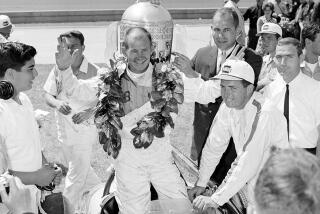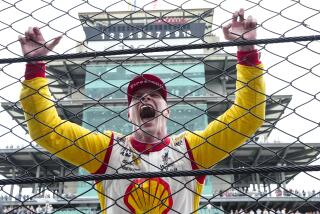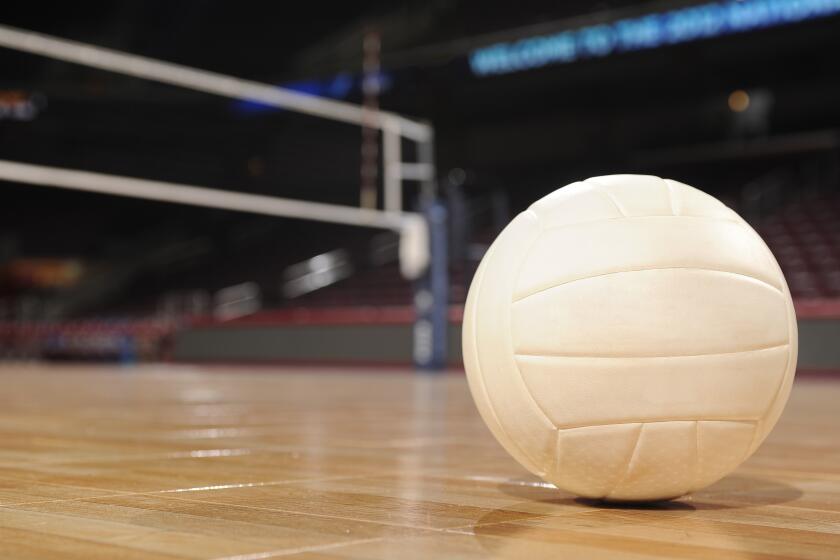On Wings of Eagles : Dan Gurney Celebrates Silver Anniversary of Formula One Milestone as His Young Drivers Clinch IMSA Title
- Share via
Twenty-five years ago, Dan Gurney made racing history of sorts when he drove a car of his design to victory in a Formula One race in Belgium. It was the first time an American had won a Formula One race in an American-built car in 46 years--and it was the first time ever for a car built by the driver.
“At the time, I didn’t think much about the significance because I didn’t figure it would be the only Formula One race I’d win with the All-American Eagle, or the last one I’d ever win in any car,” Gurney said over a cup of coffee at his All-American Racers shop in Santa Ana. “It wasn’t until later that I got to appreciate the significance of it more.”
Gurney has another reason to celebrate this year besides the silver anniversary of one of racing’s milestones.
His team of Toyota Eagles, driven by Juan Fangio II, nephew of the legendary Argentine world champion, and P.J. Jones, son of legendary Indy winner Parnelli, brought the Japanese company its first Camel GTP manufacturers’ championship. The title was clinched when his drivers finished 1-2 for the third race in a row at Road America in Elkhart Lake, Wis., two races before the season is due to end Oct. 11 at Del Mar.
The Toyotas were built in the shop, under Gurney’s supervision, where the Formula One Eagle was conceived 25 years ago.
“It all started in late 1964 when Carroll Shelby got the idea of building a car to run on Goodyears (tires) at Indianapolis,” Gurney recalled. “Firestone had a monopoly at Indy and Shelby wanted in with Goodyear. My reward, if you’d call it that, for being his partner in the project, was to get help for my Formula One effort. I had already introduced Goodyears to Formula One. We set out to design a car that could be adapted for both series.”
Gurney was already a winner on the European circuit. He scored Porsche’s only victory ever in 1962 and the Brabham team’s first victory in 1964, both in France. But he yearned for a car of his own creation.
Len Terry, who designed the Indy-winning Lotus for Jimmy Clark in 1965, was the chief architect for the AAR Eagle. Power was to come from a three-liter V-12 engine designed by former BMW engine man Aubrey
Woods and built in Rye, England, by Harry Weslake Research.
“I had worked with Weslake for some time on cylinder heads,” Gurney said. “We’d designed some that were used on Indy cars that won seven or eight races and for two winning Gulf Mirage cars in the 24 Hours of LeMans. When I asked for help in designing an engine for the Eagle it was an extension of my relationship with Weslake.”
The Eagle-Weslake V-12 made its debut in the Netherlands at the third race of the 1967 season.
“I qualified second to Jimmy Clark, who had the first Cosworth (engine) ever made in his car. He won the race and it was the first in a long line of Cosworth wins. It was odd that we both came along with something new in the same race.”
The next race was at Spa-Francorchamps in Belgium, one of the longest--8.749 miles per lap--and fastest circuits on the Formula One schedule.
“I was second again to Clark in qualifying, but early in the race he had some engine problems and I took the lead,” Gurney said. “Then I started having a high-speed miss. I was afraid I was going to lose the engine so I tried to run at less than full throttle. After I slowed down, Jackie Stewart caught and passed me, but when he went by I noticed a wisp of oil coming from his car. I decided I had to go for it, so I got back on the throttle and repassed Stewart, who, it turned out, was having gearbox problems.
“I never let up and at the end I ran the fastest lap ever run up to that time in Formula One. I averaged nearly 150 m.p.h. (148.848) even though the Spa had one 20-m.p.h. hairpin turn. I pulled 196 down the straightaway on my fast lap and was consistently over 190 every time around. The car held together and we won.”
No American driver-car combination had won in Formula One since Jimmy Murphy in a Duesenberg in the 1921 French Grand Prix.
“Like I said, I never dreamed that would be the only one I’d win,” Gurney said. “I thought it was just the beginning, but things always happened to frustrate me. I had a 42-second lead at Nurburgring with three laps to go and lost a universal joint. I led the Italian Grand Prix before I dropped out.
“The real problem was that the Eagle had more passion than funding.”
The historic No. 36 that won at the Spa was housed in Briggs Cunningham’s museum in Costa Mesa after it was retired. Miles Collier later purchased Cunningham’s collection and moved the car to a new museum in Naples, Fla.
“He had it all restored until it looks like it’s ready to race again,” Gurney said.
Gurney ran only one more full season in Europe before returning to the United States to direct a more successful program of Eagle Indy cars. Bobby Unser was the first to win an Indy 500 in a store-bought Eagle in 1968. Gordon Johncock won with another one in 1973 and two years later Unser won again in a car owned, as well as built, by Gurney.
The true measure of the Eagle success story emerged in 1973, when 21 of the 33 cars at Indianapolis were Gurney’s AAR productions. He was twice named car builder of the year by the Society of Automotive Engineers.
But the Indy car era of Gurney’s career, like Formula One, phased out for lack of funding.
“The passion was there, but passion doesn’t pay the bills,” Gurney philosophized. “Winning isn’t enough. After we won the 1974 national championship and came back to win Indy in ‘75, we looked around and found out we were broke.”
Next came Toyota, looking to make its mark in the International Motor Sports Assn. Camel GT series and hoping to cut into the successful program of its rival, Nissan. Team Toyota, under Gurney’s direction, moved slowly, but steadily--three years in GTU and three years in GTO before stepping into the high-profile GTP class in 1989.
“Toyota and I successfully worked our way through the ranks of IMSA,” Gurney said. “I feel as if GTU was primary school, GTO was high school and with GTP, we hit the university level.
“When you race for a manufacturer, the target for success is measured at the marketing level. When we moved up to GTP, we were given a three-year program and I’ll admit, up until the last two or three races I still didn’t feel real confident that we would reach our goal this year.”
The Toyota surge to unseat Nissan this season after four consecutive manufacturers’ championships and to thwart a major challenge from Jaguar, the early series leader, began when Gurney introduced a new aerodynamic package on the MX3s at Laguna Seca--the ninth race of the season. The body work was restyled and a two-tiered rear wing adopted.
Fangio and Jones finished 1-2 at Laguna Seca and came back in the next race at Portland to reverse the finish, Jones winning his first GTP race. It was the first time any team had taken the first two positions in consecutive races in IMSA history. At Road America they made it three in a row when Fangio won, followed closely by Jones.
“In racing, if you want to sustain a long-term success, you better have funding to react to the challenge from the competition,” Gurney said. “In the past, we relied on people with passion to do everything, most of it on a shoestring. Today, we have more elements first class to face the challenges. We haven’t closed the loop, but we’re much closer than we’ve ever been before.”
Helping close the loop have been the drivers, Fangio and Jones. Fangio, who joined Gurney full-time in 1990, is only one point from stopping Nissan driver Geoff Brabham’s streak of four Camel GTP championships. Jones, after a slow start in his rookie year, has come on fast and is third in the standings behind Fangio and Jaguar’s Davy Jones, one point ahead of Brabham.
Fangio, who turned 35 on Sept. 13, needs only to finish 10th or better at either Phoenix on Oct. 4 or Del Mar Oct. 11 to become Toyota’s first champion.
“I wasn’t interested in the name value of either one of them, although it did intrigue me,” Gurney said. “I was only interested in their ability to win races. I went through a lot of drivers before I settled on them. I will say, though, that perhaps their genes are coming through because both of them show the great passion for racing that Juan’s uncle and P.J.’s dad had.”
Gurney first spotted young Fangio in 1984 in a celebrity race in Miami.
“He was very inexperienced at the time, but he showed me an extraordinary talent when he found himself in an awkward position, with hardly any options to keep from crashing, yet he managed to get out of it and eventually won,” Gurney said. “He beat drivers like Emmo (Emerson Fittipaldi) and Bobby Unser.
“I kept watching him, driving Corvettes and in the ARS series with the Indy cars. I noticed that he could jump into anything and give a good account of himself. There was no hiding the fact that he was awfully good.”
Jones, 23, impressed Gurney with his four victories and six poles in 10 Firestone Firehawk series races last season.
“P.J. brings a different element to the team. Like Juan, he is extraordinarily talented, but is more empty in terms of experience. He has the ingredients that made Parnelli so tough to beat--extreme confidence and an ability to communicate with the car. He is mature beyond his age and if he has a weakness, it is his size (6 feet, 195)--not ideal for Indy cars.
“I know he’s looking to advance to Indy cars, but I’d like to have him around for some more time. Like all young drivers, he would like more stick time, but he’s probably run more test miles than I did in my entire career.
“Racing has changed since I drove my first Triumph at Torrey Pines in 1955, but there is one constant through it all--you’ve still got to have passion.”
He paused, then added with a grin, “And funding.”
More to Read
Go beyond the scoreboard
Get the latest on L.A.'s teams in the daily Sports Report newsletter.
You may occasionally receive promotional content from the Los Angeles Times.










